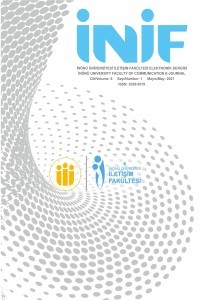ATEŞLE OYUN FİLMİNDE BİREYİN DÖNÜŞÜMÜ ÜZERİNE ARKETİPSEL BİR ANALİZ
Bu makalede, Carl Gustav Jung’un geliştirdiği analitik psikoloji kuramından hareketle Fransız yönetmen Louis Malle’in, Le Feu Follet (Ateşle Oyun, 1963), adlı filminin arketipsel analizi gerçekleştirilmiştir. Jung, nesiller boyu anlatılan güçlü hikayelerde, hikayenin kurgusunu yönlendirmeye ve insanlık hakkında çeşitli inançları aktarmaya yardımcı olan mitsel arketipler bulunduğunu savunmuştur. Jung’un kuramında arketipler, insanın kolektif bilinçdışında bulunan evrensel nitelikli, tekrar eden sembolik imgeleri ifade etmektedir. Arketipler, birçok anlatı türünde kolektif bilinçdışı alanına ait evrensel konuların betimlenmesini içeren insani eğilimlere dair motifleri yansıtmaktadır. Sinematik düzlemde oluşturulan anlatıların kolektif bilinçdışı alanına dayalı arketipsel imajlarla estetize edilmesi filmlerin Jungcu yaklaşımlar çerçevesinde analizi için elverişli olanaklar sunmaktadır. Le Feu Follet, ruhsal dengesi bozulan zayıf iradeli bir karakterin bireyleşme sürecinde yaşadığı dönüşüm üzerinden insanlığa dair evrensel sorunları yansıtan bir perspektifle insan psikolojisine dair iletiler sunmaktadır. Çalışmanın amacı, Jung’un geliştirdiği kollektif bilinçdışı kuramı çerçevesinde Le Feu Follet’in merkezi karakteri Alain Leroy’un bireyleşme sürecinde yaşadığı krizi inceleyerek sinematik imajlarla ifade edilen varoluşsal bir deneyimin insana dair felsefi iletisini aydınlatmaktır. Çalışmada analiz yöntemi olarak Jung’un dörtlü modeli uygulanmıştır. Jung’un sisteminde kişisel bütünlüğün kazanılması sürecinde persona, gölge, anima - animus ve yol gösterici arketipsel imgelerden oluşan dörtlü model oldukça işlevsel etkiye sahiptir. Bu modelde dörtlü yapı içinde yer alan her arketip, kahramanın karakterini dönüştürme potansiyeli taşır. Bu doğrultuda, Le Feu Follet’in merkezi karakteri Alain Leroy’un kişisel bütünlük kazanma sürecinde deneyimlediği varoluşsal kriz persona, gölge, anima ve yol gösterici arketipler çerçevesinde incelenerek karakterin kişiliğinde oluşan dönüşümün niteliği aydınlatılmaktadır. Filmin arketipsel analizi, merkezi karakterin bireyselleşme sürecinde kişiliğin önemli unsurları olan ego, persona ve gölge arasında kurulması gereken dengeyi sağlayamayarak trajik bir dönüşüm yaşadığını ve yaşama tutunmayı başaramayarak ölüm arzusuna yenildiğini göstermektedir.
AN ARCHETYPAL ANALYSIS ON THE TRANSFORMATION OF INDIVIDUAL IN THE FILM THE FIRE WITHIN
In this article, archetypal analysis of the film by the French director Louis Malle named Le Feu Follet (the Fire Within, 1963) is performed based on the theory of analytical psychology developed by Carl Gustav Jung. Jung argued that powerful stories that have been told for generations contain mythical archetypes that help lead story flow and convey various beliefs about humanity. In Jung's theory, archetypes express universal, repetitive symbolic images in the collective unconscious of man. Archetypes reflect motifs of human tendencies including the depiction of universal themes belonging to the field of the collective unconscious in many narrative genres. Aestheticizing the narratives created on the cinematic plane with archetypal images based on the field of the collective unconscious provides convenient opportunities for the analysis of films within the framework of Jungian approaches. Le Feu Follet, presents messages about human psychology with a perspective that reflects the universal problems of humanity through the transformation in the process of individuation of a weak-willed and psychologically unbalanced character. Jung's quartet model was used as the analysis method in the study. In Jung's system, the quartet model consisting of persona, shadow, anima - animus and wise old man archetypal images has a very functional effect in the process of gaining personal integrity. Each archetype in this quad structure has the potential to transform the character of the hero. In this direction, the nature of the transformation of the character's personality is enlightened by analyzing the existential crisis experienced by Alain Leroy, the central character of Le Feu Follet, in the process of gaining personal integrity, within the framework of persona, shadow, anima and wise man archetypes. The archetypal analysis of the film shows that the central character goes through a tragic transformation and is defeated by the desire to die against life by not being able to maintain the necessary balance between ego, persona and shadow, which are important elements of the personality, in the process of individuation.
___
- Bassil-Morozow, H. (2015). Analytical psychology and cinema. Journal of Analytical Psychology, 60(1), 132–136.
- Bennet, E.A. (2006). Jung aslında ne dedi ? (Çev. I.Çobanlı). İstanbul : Say.
- Chandler, D & Munday, R. (2018). Medya ve İletişim Sözlüğü. (Çev.B.Taşdemir). İstanbul : İletişim.
- Corey, G.(2015). Theory and Practice of Counseling and Psychotherapy. (Tenth Edition). Boston, USA : Cengage.
- Frey, H. (2004).Louis Malle. UK : Manchester University Press.
- Fordham, F.(1997). Jung psikolojisi. (4.Basım). (Çev. A.Yalçıner). İstanbul : Say.
- Hockley, L. (2004). Film çözümlemesinde Jungcu yaklaşım.(Çev. S. Gündeş). İstanbul : Es.
- Hyde, M. & McGuinness, M. (2004). Introducing Jung. UK : Icon Books.
- Indick, W. (2011). Senaryo yazarları için psikoloji. (2.basım).(Çev. E. Yılmaz & Y. Karaarslan). :İstanbul : Agora.
- Jung, C.G.(2019). Psikolojide tipler.(Çev. N.Nirven). İstanbul : Pinhan.
Jung, C.G. (2009). İnsan ve sembolleri. (4.baskı). (Çev.A.N.Babaoğlu). İstanbul : Okuyan Us.
- Jung, C.G. (2010). Psikoloji ve din. (2.Basım). (Çev. R. Karabey). İstanbul : Okyanus.
- Lanzoni, R. F. (2015). Başlangıcından günümüze Fransız sineması. (Çev.E.Yılmaz). İstanbul : Küre.
- Le Guin, U.K. (1993). The language of the night. USA, New York : Harper Perennial.
- Oscherwitz, D. & Higgins, D.M. (2009).The A to Z of French Cinema. UK : The Scarecrow Press.
- Schultz, D.P & Schultz, E.(2015). Theories of Personality. (Eleventh Edition). Boston, USA : Cengage.
- Sharf, R, S.(2014).Psikoterapi ve psikolojik danışmanlık kuramları kavramlar ve örnek olaylar. (Çev.H.M.Gündoğdu). Ankara : Nobel.
- Snowden, R. (2013). Jung kilit fikirler. (2.Basım). (Çev.K.Atakay). İstanbul : Optimist.
- Stevens, A. (2014).Jung.(Çev. Nursu Örge). Ankara : Dost.
- Storr, A. (1991). Jung. New York : Routledge.
